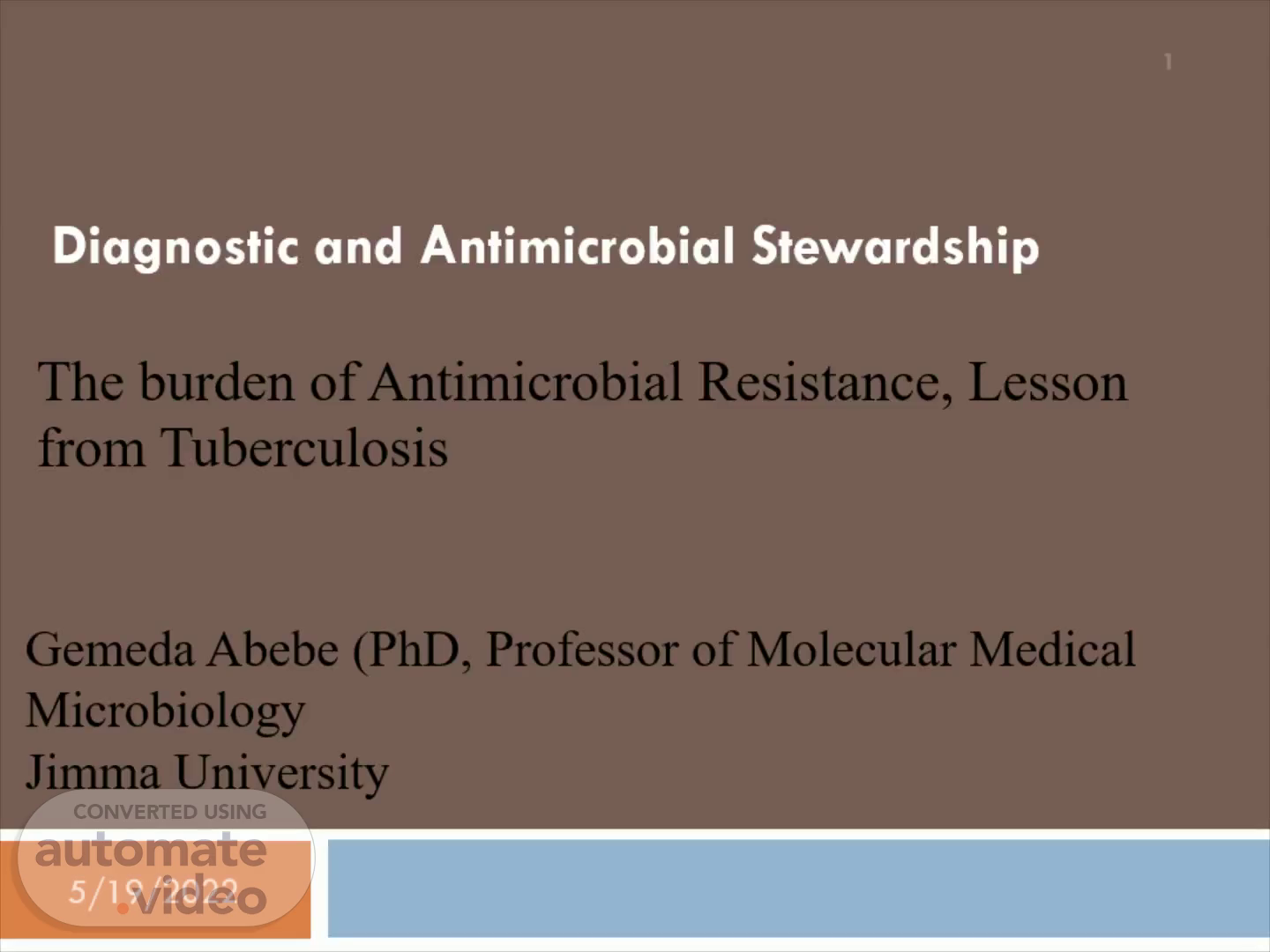
Gemeda Abebe (PhD, Professor of Molecular Medical Microbiology Jimma University
Scene 1 (0s)
Gemeda Abebe (PhD, Professor of Molecular Medical Microbiology Jimma University.
Scene 2 (12s)
Outline. Antimicrobial Resistance(AMR) Burden of AMR Use of antimicrobials How has antimicrobial resistance developed Spread of AMR Burden of AMR Lessons from TB Key messages.
Scene 3 (23s)
Antimicrobial Resistance (AMR) occurs when bacteria, viruses, fungi and parasites change over time and no longer respond to medicines making infections harder to treat and increasing the risk of disease spread, severe illness and death..
Scene 4 (40s)
The Use of Antimicrobials is widespread. Treatment & prophylaxis Human medicine Community Hospital Veterinary medicine Animal feed additives Agriculture Plant protection o o Environmen 00 0 Industry.
Scene 5 (48s)
Antimicrobials in human health. Prevent or treat infections by Bacteria Antibiotics (also known as antibacterials) such as cellulitis, Urinary Tract Infection. tutHculosis (TE). Infa:tions (STIs) like gonowhcea Prevent or treat infections caused by Fungi Antifungals Antivirals Antimicrobials are medicines used to prevent and treat by microorganisms In humans, animals and plants Antiparasitics An antimicrobial such as thrush, ring worm and attÉteS foot drug works against only one tyg:E of organism Antimicrobial Resistance: when the microorganisms change or mutate over time and get to a gx)int 'Where they no Onger rtsgxjnd to medicines previously used to treat them Prevent or treat infections caused by Viruses such as cnlds. flu, chicken pox/shndes, 19 or HIV Prevent or treat infections by Parasites such as malaria. thread,wm and headlice.
Scene 6 (1m 15s)
Antimicrobial resistance is a natural phenomenon.
Scene 7 (1m 31s)
The delivery of more complex health care which may require longer use of antibiotics.
Scene 8 (1m 42s)
Spread of AMR. humans antimicrobial animals sew age environment fcx»d manure.
Scene 9 (1m 50s)
Globally- 700,000 deaths/year including 230,000 people who die from MDR-TB (WHO and UN).
Scene 10 (2m 5s)
Compared to the approximate 6.3 million deaths worldwide from COVID (2019 to the present date), the annual burden of AMR is almost double..
Scene 11 (2m 27s)
Resistance Associated with resistance Attributable to resistance 8 150 100 50 o D super-region Central Europe, eastern Europe, and central Asia High income Latin America and Caribbean North Africa and Middle East South Asia Southeast Asia, east Asia, and Oceania Sub-Saharan Africa GBD region.
Scene 12 (2m 45s)
Lower respiratory infections accounted for more than 1·5 million deaths associated with resistance in 2019..
Scene 13 (3m 6s)
MRSA- caused more than 100 000 attributable deaths in 2019.
Scene 14 (3m 22s)
Deaths attributable to AMR every year compared to other major causes of death.
Scene 15 (3m 38s)
Deaths Associated to AMR each year until 2050. Europe. 390,000 North America 017.000 Africa Latin America 392,000 • Asia Oceania 22,000 Mortality per 10,000 population "eths s 5 7 9.
Scene 16 (3m 54s)
Deaths Associated and Attributable to AMR by Infection syndrome(global).
Scene 17 (4m 5s)
Tuberculosis had the dubious distinction of being the first major infectious disease to become resistant to all known antibiotics..
Scene 18 (4m 22s)
Tuberculosis evolution. 1960s- an entirely curable disease.
Scene 19 (4m 37s)
1. In the early 1990s, more than a dozen outbreaks of MDR-TB in different countries caused worldwide alarm—90% of patients died..
Scene 20 (4m 54s)
In 2013, DR-TB was on the cover of Time magazine..
Scene 21 (5m 16s)
Lessons from TB ?- Continuous updates on guidelines.
Scene 22 (5m 52s)
Lessons from TB ? Continuous updates on guidelines.
Scene 23 (6m 24s)
WHO c nsolidated guidelines on drug-resistant uberculosis treatment.
Scene 24 (6m 36s)
The 1990 MDR-TB outbreaks shaded light on widespread deficiencies in diagnostics and laboratory systems, surveillance systems, and resource allocation..
Scene 25 (6m 59s)
The lesson that applies to all pathogens is that laboratories and surveillance are crucial..
Scene 26 (7m 15s)
GLASS ( Global Antimicrobial Resistance and Use Surveillance System) is an example to which Ethiopia has subscribed..
Scene 27 (7m 32s)
Lessons from TB-The lab system. 5/19/2022. 27. Indicators reported to GLASS 9 surveillance sites participating to the national surveillance system 8 hospitals 1 outpatient facilities 9 laboratories performing AST EQA provided to all laboratories NRL Established AST standard CLSI EQA Provided in 2020 data call all national surveillance sites reported to GLASS NCC Establishment in progress National Action Plan In place.
Scene 28 (7m 44s)
Following the MDR-TB outbreaks IPC was enacted in many developed countries but poorly in LMICs..
Scene 29 (7m 59s)
The public health responses to infections are often compartmentalized at the highest levels..
Scene 30 (8m 15s)
The response to MDR-TB was driven not so much by resurgent TB, because TB had always been present, but by the sudden risk and fear of lethal, highly drug-resistant TB..
Scene 31 (8m 34s)
Ethiopia is no more MDR-TB high burden country. National Success stories in TB program.
Scene 32 (8m 43s)
AMR is an imminent calamity facing humankind on an even greater scale..
Scene 33 (8m 57s)
Comments ? Questions?. 5/19/2022. 33. 0 90 0.
Scene 34 (9m 3s)
5/19/2022. 34. Image result for thank you hats off.